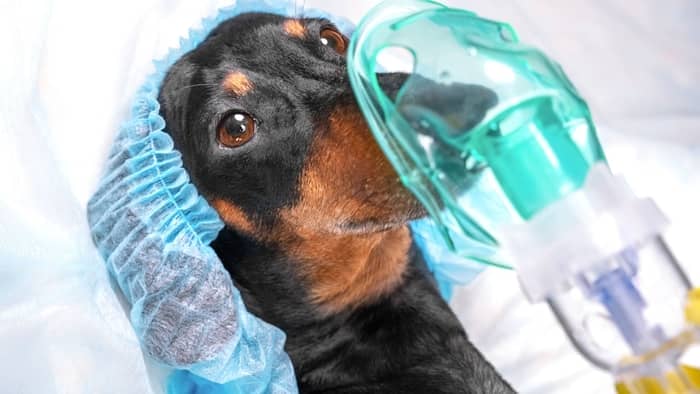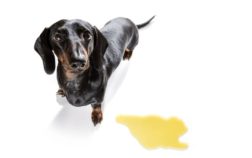If you’ve just now gotten your first dachs you may be wondering what are the main dachshund hind leg problems and what can you do about them. Looking after a pet is a phenomenal experience but it also involves quite a bit of care. And, even though Doxies are a relatively healthy breed, they have a few potential issues you need to be aware of.
Given their unique body structure, it’s hardly surprising that back and hind leg issues are something to keep in mind. So, what should you do if you see a dachshund limping back leg? And even more importantly – how can you prevent such problems from happening in the first place?
The 5 Main Dachshund Hind Leg Problems
It’s a little-known fact that the signature elongated body and short legs of Doxies are actually the results of dwarfism. That’s right – all Doxies are technically dwarfs. This isn’t the result of some recent selective breeding either – researchers have discovered that this happened in the very early days of the domestication of dogs.
There are many other dog breeds that are also the result of dwarfism. These include pugs, corgis, bulldogs, basset hounds, and quite a few terrier breeds – pretty much all short-legged dogs.
What Does This Dwarfism Mean For Your Dog?
Dwarfism is unfortunately known to lead to quite a few potential issues with the bone and spinal health of the individual. Because breeds like the dachshund have been the result of dwarfism for thousands of years, a lot of those problems and risks have been bred out over time. That’s why Doxies can both have dwarfism and still be relatively healthy.
However, some health risks still exist and those revolve mostly around the Doxies’ backs and hind legs. So, what are the main dachshund leg problems you should look out for?
1. Hip dysplasia and elbow dysplasia
This problem is not unique to dachshunds and not even just to other short-legged breeds. Neither hip nor elbow dysplasia are even just specific conditions – they are general terms that encompass multiple different issues with the hip and elbow joints.
In the case of Doxies, elbow dysplasia is the more common problem. It occurs when one of the three leg joints gets deformed for any of multiple different reasons. When that happens your dog’s weight will get unevenly spread, the pooch will start experiencing pain, and the risk of arthritis will be significantly increased. Seeing a dachshund limping back leg is a clear indication that elbow dysplasia has been allowed to go out of control.
2. Antebrachial growth deformity
This isn’t actually a hind leg problem but it affects the Doxies’ front legs instead. We are including it, however, as it is a pretty serious and noteworthy condition. A dog with an Antebrachial growth deformity will have one front leg that grows larger than the other. This leads to an uneven posture and a lot of other problems down the line. Surgery is usually necessary to fix the issue.
3. Bowlegged syndrome
Also called “pes varus”, bowlegged syndrome is exactly what it sounds like. Dogs with this condition will have severely curved hind legs which makes walking next to impossible. If not corrected as soon as possible, pes varus can make a dog’s life extremely unpleasant and lead to other problems down the line.
Fortunately, surgical intervention can solve the issue. What’s even better is that this is a very rare condition.
4. Luxating patella
This condition, also known as patellar luxation, can lead to the dog’s kneecaps sliding in and out of place. This can make walking and running both uncomfortable and painful for your dachshund. It also leads to a lot of extra stress on the other leg joints and can cause arthritis.
Luxating patella also gets progressively worse over time. It too can be corrected via surgery but the sooner it’s done, the better.
5. Spine/back problems such as Intervertebral disc disease (IVDD)
If you see dachshund paralyzed back legs, the core reason is almost always spinal problems. You will usually see increased leg shaking or difficulties walking before the condition progresses to paralysis.
This condition can affect either the front or the hind legs of the dachs, depending on where in the spine the slipped disk is. If your dog’s front legs start exhibiting problems, the issue is near the neck. If we’re talking about dachshund hind leg problems, the slipped disk is further down the spine. Treatment will depend on how progressed the condition is so it’s important to call your vet as soon as you see a problem.
What Are The First Symptoms Of Dachshund Hind Leg Problems?
Ideally, you won’t wait until the dog starts showing obvious difficulties walking, limping, or paralysis. Instead, there are quite a lot of signs you can watch out for such as:
- Changes in the Doxie’s standing stance
- A different walking pattern such as shorter steps
- Decreased playfulness
- A grumpy and bad mood
- The dog has stopped running for things it used to run for before
The Main Treatments For Dachshund Leg Problems
Unfortunately, most dachshund hind leg problems require surgical intervention. That’s because they are actual bone, joint, and skeletal issues and aren’t just a matter of hormones, infections, or anything similar. The good news is that almost all of the dachshund leg problems are treatable if caught early.

So, regular vet checks up are extremely important with this breed. Going for 2 routine visits per year is a must – don’t just settle for the single annual vaccination visit. Also, when you go to the vet make sure to tell them everything you’ve observed about the dog during the last 6 months including any of the behavioral changes we mentioned above.
Preventative Measures To Help You Avoid Dachshund Hind Leg Problems
The other good news is that most of these dachshund leg problems can either be prevented or mitigated with the right care. Naturally, the key first step is to make sure that you’ve got a healthy puppy from the get-go. This means only working with reputable breeders and asking for a health certificate before you commit to a purchase/adoption.
Once you’ve got your dachs pet, the main preventative steps are quite simple – just maintain a good and nutritious diet and give your dog adequate and regular exercise. An adult dachs typically need 45 to 60 minutes of outdoors walking time, usually distributed between two walks.
Another good note is to limit your Doxie’s need to jump up and down in its day-to-day life. This means avoiding stairs as well as picking up your dachs out of the car instead of letting the dog jump out. Putting a few ramps here and there around your home can be very helpful as well.
Read moe about: Quick Guide of the Main Dachshund Pitbull Mix Health Problems




